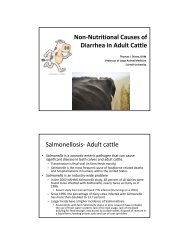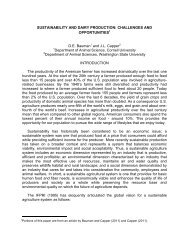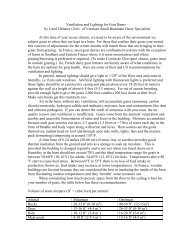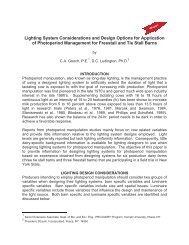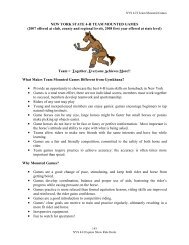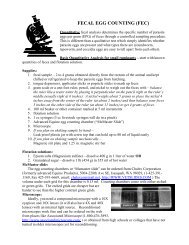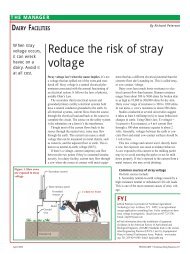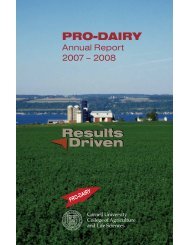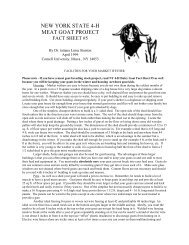2009 Proceedings of the Cornell Nutrition Conference For Feed ...
2009 Proceedings of the Cornell Nutrition Conference For Feed ...
2009 Proceedings of the Cornell Nutrition Conference For Feed ...
Create successful ePaper yourself
Turn your PDF publications into a flip-book with our unique Google optimized e-Paper software.
RESEARCH AT MINER INSTITUTE WITH LOW-STARCH DIETS<br />
We (Dann et al., 2008) used 12 multiparous, mid-lactation cows in a replicated 3×3<br />
Latin square design study with 21-d periods (7-d collection) to determine <strong>the</strong> effect <strong>of</strong><br />
feeding diets containing 18, 21, and 25% starch (Table 2) on lactational performance,<br />
ruminal fermentation, and total tract nutrient digestibility (Table 3). Dietary starch was<br />
reduced by decreasing <strong>the</strong> amount <strong>of</strong> corn grain and increasing <strong>the</strong> amount <strong>of</strong> beet<br />
pulp, wheat middlings, and distillers grains. Cows were able to maintain high<br />
productivity on all diets. Dry matter intake (26.5 kg/d), milk yield (43.5 kg/d), milk fat<br />
content (3.54%), milk true protein content (3.14%), and efficiency <strong>of</strong> milk production<br />
(1.65 kg milk/kg DMI) were unaffected by diet. Diet also had no effect on ruminal pH<br />
averaged over 24 h (6.06), total volatile fatty acids (150 mM), acetate:propionate (2.4),<br />
or microbial nitrogen yield (584 g/d). Total tract digestibility <strong>of</strong> organic matter was higher<br />
for <strong>the</strong> 25% starch diet (69.2%) compared with <strong>the</strong> 21% (67.3%) and 18% (67.0%)<br />
starch diets but was <strong>of</strong> little biological relevance. Digestibility <strong>of</strong> NDF and starch was not<br />
affected by diet.<br />
Table 2. Ingredient and chemical composition (dry matter basis) <strong>of</strong> diets containing 18,<br />
21, or 25% starch fed to lactating Holstein cows.<br />
Diet<br />
Item 18% starch 21% starch 25% starch<br />
Ingredient composition<br />
Corn silage, % 30.2 30.2 30.4<br />
Grass silage, % 18.5 18.4 18.6<br />
Alfalfa hay, % 5.0 5.0 5.1<br />
Soybean meal (48%), % 7.1 8.0 8.4<br />
Corn, finely ground, % 3.4 10.1 16.9<br />
Beet pulp, % 6.7 3.4 -<br />
Wheat middlings, % 13.4 10.1 6.8<br />
Distillers grains, % 9.7 8.7 7.8<br />
O<strong>the</strong>r, % 6.0 6.1 6.0<br />
Chemical composition<br />
Crude protein, % 17.4 17.6 17.2<br />
Acid detergent fiber, % 22.2 20.8 20.0<br />
Neutral detergent fiber, % 38.0 36.5 34.2<br />
<strong>For</strong>age neutral detergent fiber, % 24.7 24.7 24.8<br />
Sugar, % 4.8 3.9 3.6<br />
Starch, % 17.7 21.0 24.6<br />
Starch 6-h digestibility, % starch 82.5 77.3 73.6<br />
Rumen fermentable starch, % 14.6 16.2 18.1<br />
In summary, with <strong>the</strong> sources <strong>of</strong> corn grain, corn silage, and byproducts fed in this<br />
study, we observed no effect on feed intake, milk component production, ruminal<br />
metabolism, or microbial protein yield when dietary starch was varied between 18 and<br />
25%. It is important to note that, as dietary starch decreased, ruminal fermentability<br />
increased and consequently <strong>the</strong> range between <strong>the</strong> 25 and 18% starch diets in rumen<br />
43



